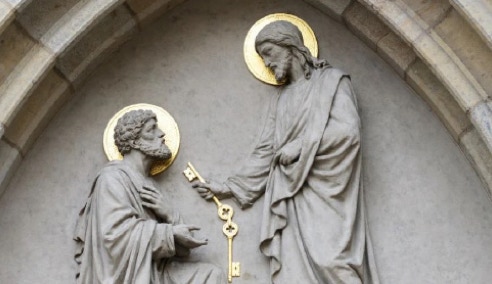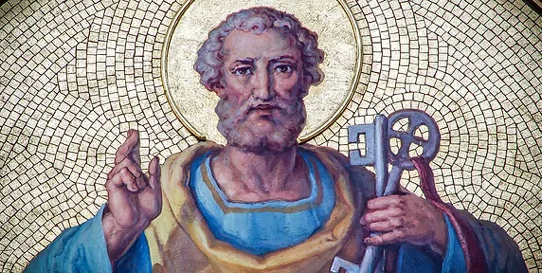


The Church
The Church
Catholic Outlook
Catholic Outlook

Catholic Outlook
The Church
The Church
__________ Recent Additions __________
Catholic Outlook
Catholic Outlook
I Tell You That You Are Peter
Is Simon the rock on which Jesus will build his church?
Gary Hoge

When Jesus asked his disciples, “But who do you say that I am?” Simon answered, “You are the Christ, the Son of the living God.” Jesus replied to him,
Blessed are you, Simon son of Jonah, for this was not revealed to you by flesh and blood, but by my Father in heaven. And I tell you that you are Peter (Πέτρος - Petros), and on this rock (πέτρᾳ - petra) I will build my church, and the gates of Hades will not overcome it. I will give you the keys of the kingdom of heaven; whatever you bind on earth will be bound in heaven, and whatever you loose on earth will be loosed in heaven (Matthew 16:18-19).
Who or what is the “rock” on which Jesus says he will build his church? The answer to that question is contentious, more for theological reasons than for grammatical ones.
Catholics (and many Protestants) believe that Jesus was referring to Simon himself as the “rock.” But many other Protestants argue that because Matthew used different words for “Peter” and “rock” (petros vs. petra), Jesus wasn’t referring to Simon, but to himself, the big boulder, in contrast to Simon, the little rock:
Christ Himself is called the “chief cornerstone” (1 Peter 2:6, 7). The chief cornerstone of any building was that upon which the building was anchored. If Christ declared Himself to be the cornerstone, how could Peter be the rock upon which the church was built?1
Or perhaps Jesus was referring to Peter’s confession of faith, “You are the Christ, the Son of the living God.”
At this point, Jesus declares that God had revealed this truth to Peter. The word for “Peter,” Petros, means “a small stone” (John 1:42). Jesus used a play on words here with petra (“on this rock”) which means “a foundation boulder,” as in Matthew 7:24, 25 when He described the rock upon which the wise man builds his house. Peter himself uses the same imagery in his first epistle: the church is built of numerous small petros, “living stones,” (1 Peter 2:5) who, like Peter, confess that Jesus is the Christ, the Son of the living God, and those confessions of faith are the bedrock of the church.2
Before we do a deep dive into Greek grammar, bear in mind that when this scene played out, Jesus wasn’t speaking Greek, he was speaking Aramaic. He didn’t call Simon Petros, he called him Kepha.
We know that for a fact because when Jesus first met Simon, he said,
“You are Simon the son of John; you shall be called Kepha3 (which is translated Petros)” (John 1:42).
So, this verse tells us explicitly that Simon’s new name, Petros, is a translation into Greek of the Aramaic word Kepha. Eight other times in the Greek New Testament Simon is called Kepha instead of Petros.4
It’s important to understand the play on words Jesus was using here. If you’re old enough to remember who movie star Rock Hudson was, imagine Jesus was talking to him, and the conversation went like this:
“I liked your latest movie, Rock, it was funny. I see potential in you. And I tell you that you are Rock, and on this rock I will build my church.”
It’s a pun because Rock is the man’s name, and it’s also a word referring to a foundation. The Aramaic word Kepha worked well for that pun because it can be a man’s name, and it’s also the word for “rock.” So, Jesus said, “I tell you that you are Kepha, and on this kepha I will build my church.” Protestant theologian D.A. Carson explains:
[T]he the underlying Aramaic is in this case unquestionable; and most probably kepha was used in both clauses (“you are kepha” and “on this kepha”), since the word was used both for a name and for a “rock.” The Peshitta (written in Syriac, a language cognate with Aramaic) makes no distinction between the words in the two clauses. The Greek makes the distinction between petros and petra simply because it is trying to preserve the pun, and in Greek the feminine petra could not very well serve as a masculine name.5
As Carson illustrates, 40 years after Jesus said those words in Aramaic, when Matthew sat down to translate them into Greek, he had a problem. He needed to preserve the “rock-rock” pun, but the Greek word for rock, petra, is feminine. He couldn’t call his pal Simon “Petra,” because that’s a woman’s name, a name that’s still in use today.6 It would be like calling him Simone instead of Simon. So, Matthew changed the feminine ending (-ᾳ) to a masculine ending (-ος), thus changing petra to petros.
Tripping over the Petros
As it turns out, Petros was a preexisting word in Classical Greek, centuries before the New Testament was written, and it could mean “a small stone.” But even then, according to Lutheran theologian Oscar Cullmann, “one cannot differentiate too strictly between petra and petros; they are often used interchangeably.”7 Also, according to D.A. Carson, the distinction between petra and petros in Classical Greek was “largely confined to poetry.”8
None of that really matters, though, because the New Testament wasn’t written in Classical Greek, it was written in Koine (or “common”) Greek. By the time Koine Greek had developed, the word petros had fallen into disuse.9 In fact, according to Protestant New Testament scholar R.T. France, “petros as a common noun is unlikely to have been familiar to Matthew’s readers.”10
This is borne out by the fact that the word petros occurs 162 times11 in the New Testament, and every single occurrence is Simon’s name. Not once is petros used as a common noun to mean a stone, or a rock, or anything else.
But wait, didn’t the quote above say, “Peter himself uses the same imagery in his first epistle: the church is built of numerous small petros, ‘living stones,’ (1 Peter 2:5)”?12 Didn’t Peter himself call believers small petros? No, he didn’t. He used the word lithos, not petros. He wrote, “you also, like living stones (lithoi), are being built into a spiritual house.”
Lithos (λίθος) is the word commonly used in the New Testament to refer to small rocks or stones. For example, Romans 9:33 says, “See, I lay in Zion a stone (lithos) that causes people to stumble and a rock (petra) that makes them fall.” Notice that Paul uses petra here to indicate a rock that’s small enough to trip over. Petra doesn’t always mean “large boulder.”
What’s in a Name?
Another indicator that Jesus was referring to Simon as the rock is that Jesus changed his name. We’re so used to calling Simon “Peter,” that we can lose sight of the fact that in the Bible a name change was a big deal. “A name change often meant a completely altered life from the one the person had lived before.”13 For example, God changed Abram’s name to “Abraham,” which meant “Father of a Multitude.” He changed Jacob’s name to Israel, “because you have struggled with God and with humans and have overcome” (Genesis 32:28). And he changed Simon’s name to Peter, the rock, because “on this rock I will build my church.”
The Keys of the Kingdom
After Jesus told Simon, “You are Kepha and on this kepha I will build my church,” he added, “I will give you the keys of the kingdom of heaven; whatever you bind on earth will be bound in heaven, and whatever you loose on earth will be loosed in heaven.” (Matthew 16:19)
If you’re familiar with the Old Testament you might notice a parallel here between what Jesus said to Peter and what was said of Eliakim, the royal steward under King Hezekiah, in Isaiah 22:22,
He will be a father to those who live in Jerusalem and to the house of Judah. I will place on his shoulder the key to the house of David; what he opens no one can shut, and what he shuts no one can open.
Eliakim
I will place on his shoulder the key to the house of David;
what he opens no one can shut, and what he shuts no one can open.
Peter
I will give you the keys of the kingdom of heaven;
whatever you bind on earth will be bound in heaven, and whatever you loose on earth will be loosed in heaven.
Jesus appointed His servant Peter as “chief steward” over his church, just as Eliakim was the chief steward over Hezekiah’s kingdom. Protestant author F. F. Bruce concurs:
And what about the keys of the kingdom? The keys of a royal or noble establishment were entrusted to the chief steward or major domo; he carried them on his shoulder in earlier times, and there they served as a badge of the authority entrusted to him. … So in the new community which Jesus was to build, Peter would be, so to speak, chief steward.14
In addition to being appointed “chief steward,” Peter was also given the authority to “bind” and “loose.” Later, the other apostles were given a similar authority (see Matt. 18:18). What does this mean? According to Ralph Earle, Professor of New Testament at Nazarene Theological Seminary:
Even more striking [than the keys] is Jesus’ statement that whatever Peter bound on earth would be bound in heaven, and whatever he loosed on earth would be loosed in heaven. What is meant by bind and loose? M’Neile explains: “‘Bind’ and ‘loose’ appear to represent the Aramaic … technical terms for the verdict of a teacher of the Law who, on the strength of his expert knowledge of the oral tradition, declared some action or thing ‘bound’ i.e. forbidden, or ‘loosed’ i.e. permitted.” In other words, Peter would give decisions, based on the teachings of Jesus, which would be bound in heaven that is honored by God.15
This is why Peter has often been depicted in art carrying two keys: one to bind, one to loose.

If we consider the New Testament as a whole, Peter’s role as “first among equals” becomes clear:16
“Simon and his companions” (Mark 1:36).
“His disciples and Peter” (Mark 16:7).
“Peter and his companions” (Luke 9:32).
“Peter and the other apostles” (Acts 2:37).
“Peter and the other apostles” (Acts 5:29).
“The other apostles and the Lord’s brothers and Cephas” (1 Corinthians 9:5).
Given all the biblical evidence, Methodist biblical archaeologist William F. Albright wrote, “To deny the pre-eminent position of Peter among the disciples or in the early Christian community is a denial of the evidence.”17
Peter is the Rock
It should be clear that there’s no basis, either in the Aramaic Jesus spoke, or in the Greek Matthew wrote, to deny that Peter himself is the rock on which Jesus said he would build his church. In fact, many modern Protestant scholars acknowledge that Peter is the rock to which Jesus referred.
For instance, Donald A. Hagner of Fuller Theological Seminary wrote,
The natural reading of the passage, despite the necessary shift from Petros to petra required by the word play in the Greek (but not the Aramaic, where the same word kepha occurs in both places), is that it is Peter who is the rock upon which the church is to be built. … The frequent attempts that have been made, largely in the past, to deny this in favor of the view that the confession itself is the rock (e.g., most recently Caragounis) seem to be largely motivated by Protestant prejudice against a passage that is used by the Roman Catholics to justify the papacy.18
Methodist biblical archaeologist William F. Albright wrote,
This [the word “Peter”] is not a name, but an appellation and a play on words. There is no evidence of Peter or Kephas as a name before Christian times. . . . Peter as Rock will be the foundation of the future community. Jesus, not quoting the Old Testament, here uses Aramaic, not Hebrew, and so uses the only Aramaic word which would serve his purpose. In view of the background of vs. 19, one must dismiss as confessional interpretation any attempt to see this rock as meaning the faith, or the Messianic confession, of Peter.19
David Hill, a Presbyterian minister at the University of Sheffield wrote,
It is on Peter himself, the confessor of his Messiahship, that Jesus will build the Church. The disciple becomes, as it were, the foundation stone of the community. Attempts to interpret the rock as something other than Peter in person (e.g. his faith, the truth revealed to him) are due to Protestant bias, and introduce to the statement a degree of subtlety which is highly unlikely.20
Finally, Lutheran theologian Oscar Cullmann wrote,
The idea of the Reformers that He [Jesus] is referring to the faith of Peter is quite inconceivable … For there is no reference here to the faith of Peter. Rather, the parallelism of ‘thou art Rock’ and ‘on this rock I will build’ shows that the second rock can only be the same as the first. It is thus evident that Jesus is referring to Peter, to whom he has given the name Rock … to this extent Roman Catholic exegesis is right and all Protestant attempts to evade this interpretation are to be rejected.”21
For even more Protestant scholarship on this subject, see my paper “Protestant Scholars Agree: Peter Is the Rock.”
Jesus is ultimately the head of the Church, and it’s true that Simon’s confession of faith in him is foundational for all of Christ’s disciples. But it’s clear that the primary meaning of Matthew 16:18-19 is that impulsive, earnest, unsteady Simon would become in some sense the rock on which Jesus would build his church, and the man to whom he would give the keys of the kingdom of heaven, and the authority to bind and loose.
__________
1 “What is the rock in Matthew 16:18,” https://www.gotquestions.org/upon-this-rock.html.
2 “What is the rock in Matthew 16:18,” https://www.gotquestions.org/upon-this-rock.html.
3 The word that appears here in English bibles is “Cephas,” which is the Latin version of the Greek word Κηφᾶ (Kepha), which itself is the phonetic translation of the Aramaic word Kepha. Interestingly, the correct pronunciation of the Latin word Cephas is “Keyfas,” but we English speakers usually mispronounce it “Seefas.”
4 1 Corinthians 1:12, 1 Corinthians 3:22, 1 Corinthians 9:5, 1 Corinthians 15:5, Galatians 1:18, Galatians 2:9, Galatians 2:11, and Galatians 2:14.
5 D.A. Carson, The Expositor’s Bible Commentary, Volume 8 (Matthew, Mark, Luke), ed. Frank E. Gaebelein, (Grand Rapids, MI: Zondervan, 1984), 368.
6 There were approximately 28,148 women named Petra in the United States as of 2024 — “First Name PETRA,” MyNameStates.com, https://www.mynamestats.com/First-Names/P/PE/PETRA/index.html
7 Oscar Cullman, Theological Dictionary of the New Testament, Vol. VI, pg. 95.
7 D.A. Carson, The Expositor’s Bible Commentary, Volume 8 (Matthew, Mark, Luke), ed. Frank E. Gaebelein, (Grand Rapids, MI: Zondervan, 1984), 368.
9 John Nolland, New International Greek Testament Commentary, Matthew, pg. 669.
10 R.T. France, The Gospel of Matthew, pg. 621.
11 https://www.bibletools.org/index.cfm/fuseaction/Lexicon.show/ID/G4074/Petros.htm
12 What is the rock in Matthew 16:18,” https://www.gotquestions.org/upon-this-rock.html.
13 “Why are There So Many Name Changes in the Bible?”, https://www.christianity.com/wiki/bible/why-are-there-so-many-name-changes-in-the-bible.html
14 F. F. Bruce, The Hard Sayings of Jesus, (Downers Grove, IL: InterVarsity, 1983), 143-144.
15 Ralph Earle, “Matthew,” in A.F. Harper and others, eds., Beacon Bible Commentary, vol. 6, (Kansas City, MO: Beacon Hill, 1964), 156.
16 This is an edited version of “50 New Testament Proofs for Peter’s Primacy & The Papacy,” by Dave Armstrong, https://www.patheos.com/blogs/davearmstrong/2015/10/50-nt-proofs-for-petrine-primacy-the-papacy.html.
17 W. F. Albright and C. S. Mann, Matthew (Garden City, NY: Doubleday & Co., 1971), 195.
18 Matthew 14-28, Word Biblical Commentary, vol. 33b, (Dallas: Word Books, 1995), 470.
19 W. F. Albright and C. S. Mann, Matthew (Garden City, NY: Doubleday & Co., 1971), 195.
20 David Hill, The Gospel of Matthew (Grand Rapids, MI: Eerdmans, 1972), 261.
21 Cullmann, Theological Dictionary of the New Testament, pg. 108.
Copyright © 2024 Catholicoutlook.me
MENU